The immediate postpartum time is one of the hardest and most confusing times in the life of a mom.
There are so many different potential struggles, even with a healthy pregnancy and birth.
You’re so tired, you’re adjusting to a larger family, possibly nursing or pumping, and your body doesn’t feel like your own.
Alongside that, you might be worried...
"What if I can't get back to the example of health and body confidence I want my kids to see as they grow up?"
In today's blog, you'll learn the methods we use with postpartum clients to help you lose the fat, restore your hormones & metabolism, and feel more confident in your body than ever before.
[*DISCLAIMER: I’m going to focus on the moms who have had a vaginal birth and who have no postpartum depression or other physical or hormonal restrictions that are out of the scope of myself and this blog. If those things apply to you, consult your doctor, and/or a professional who specializes in your specific case.]
1: USE A PHASIC DIETING APPROACH
The phasic dieting method is an essential part of what we focus on with all clients, but is especially important here.
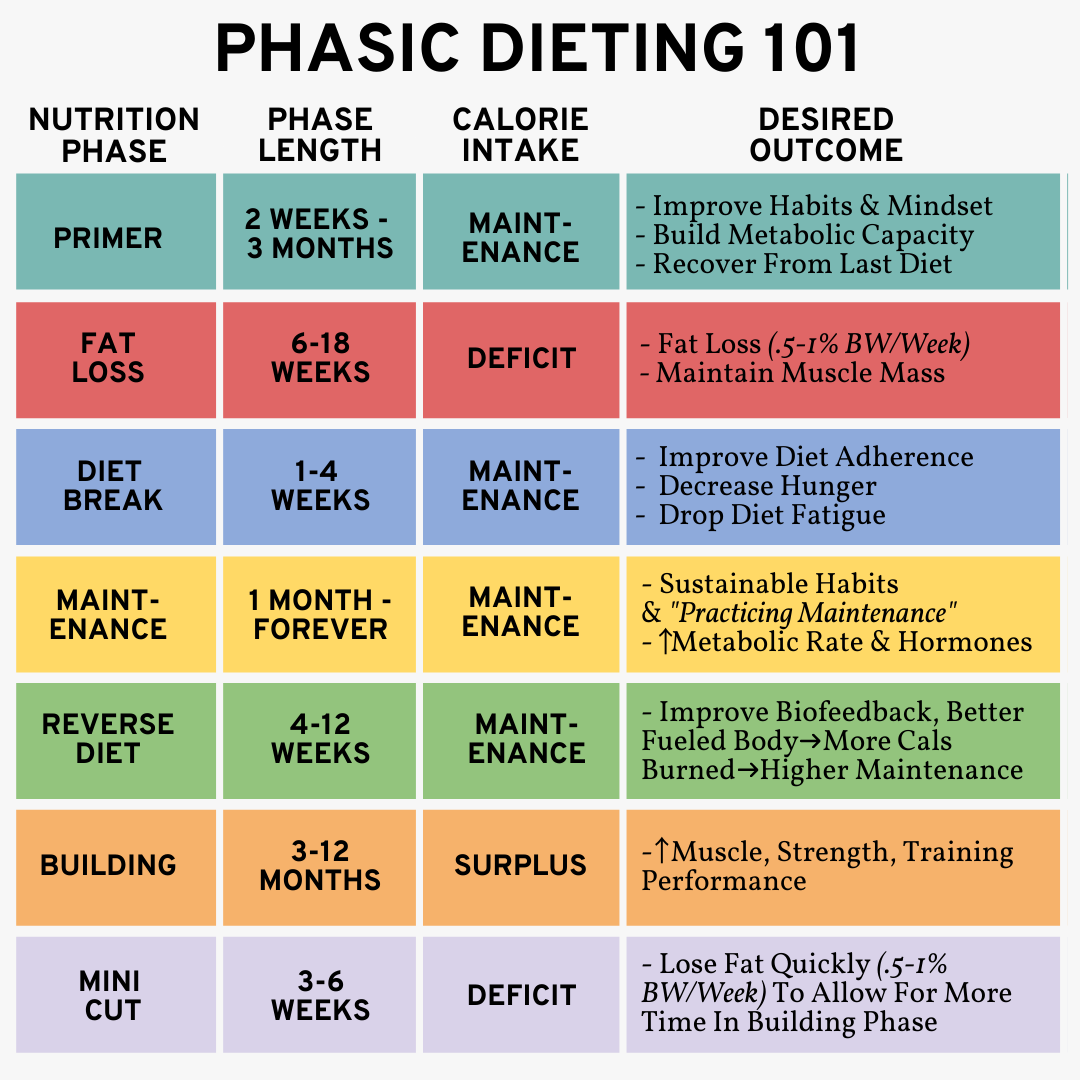
In this case, the first few months should be focused on priming and building phases.
Here, our goal is teaching you how to fuel your body to add metabolism boosting lean muscle, and giving your body all the nutrients it needs to restore your hormonal health, along with the calories you need to support your child if you’re breastfeeding.
You’ll see increases in lean muscle definition and strength in this phase, and your overall body composition (how your body looks) improve, but it’s important to understand that the goal here isn't fat loss. We’re focusing on restoring your health and metabolism to set you up for a very successful fat loss phase later.
So as you've probably gathered, one mistake many moms make (myself included) is to jump into a diet again too quickly.
You’ve just spent the last 9 (really 10, nobody talks about that!) months pregnant, possibly feeling sick, and not able to exercise and eat like you normally do.
Your body hasn’t been your own and you’re ready to get back to “normal.”
As I said, I did this too and I totally get it.
The problem here is, a diet is the last thing you need for a while.
You are expending a lot of energy to physically heal, and you are most likely also trying to produce breast milk.
(The amount of calories you burn to breastfeed is dependent on your milk supply and other factors, but a general guideline usually given is that you need about 500 calories per day for milk - so learning to fuel your body properly is important here!)
When you restrict calories, you produce less milk, and that number goes down. This increased need for calories to produce milk has created the myth that breastfeeding will melt off the baby fat, which is not the case for everyone.
Regardless if you’re nursing or bottle-feeding, you are still physically recovering from pregnancy and delivery, and you need the calories as a source of energy for recovery.
We suggest clients take at least 3 months focusing on restoring your health, hormones, etc. in the primer and building phases before you attempt to lose fat.
Your hormones won’t regulate for a while postpartum and dieting can prolong or exacerbate that.
That said, understand that most moms can experience a pretty crazy body recomposition effect(building muscle & losing fat at the same time) at maintenance for quite a while... if they take the right approach to their training and nutrition.
A great example of this comes from one of our current clients:
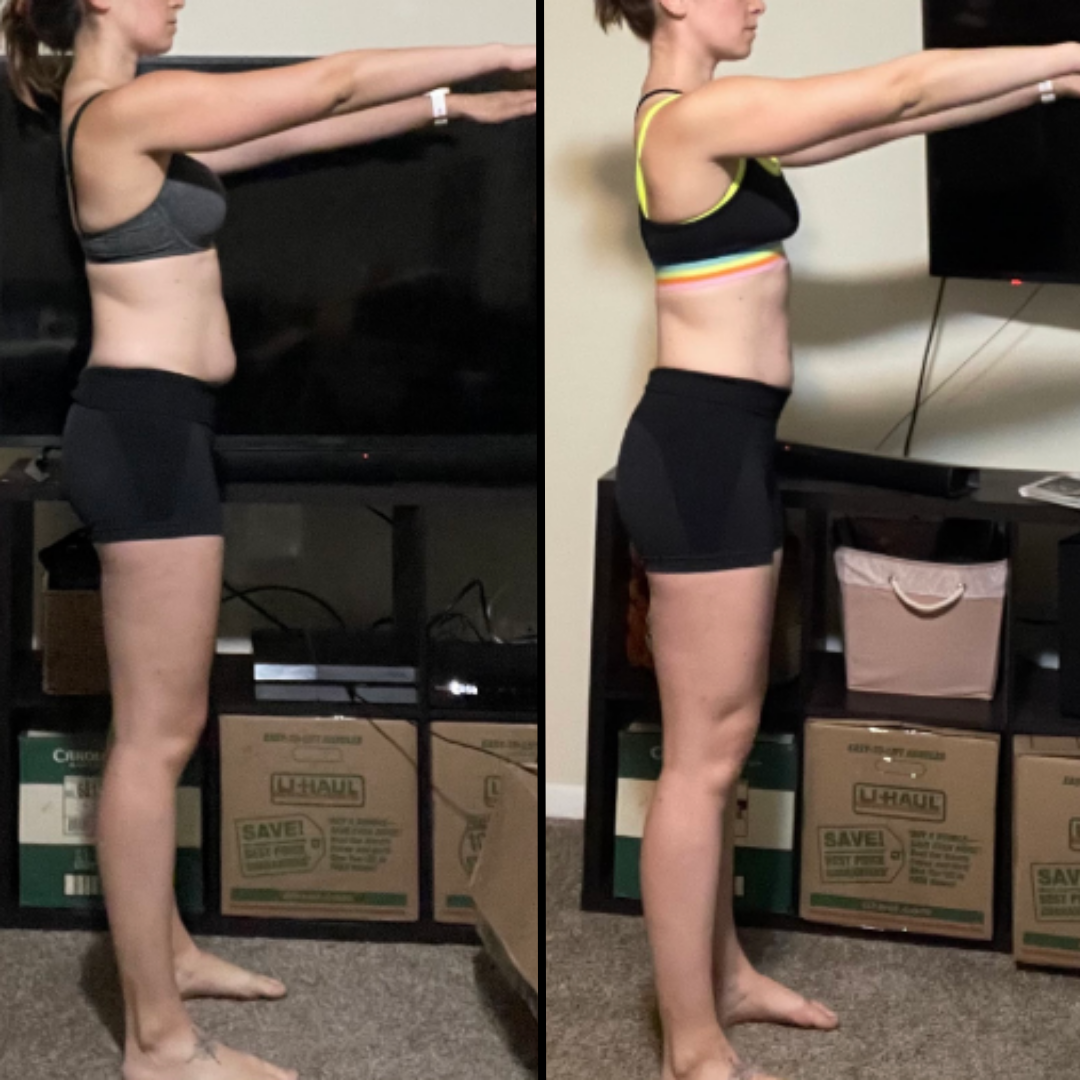
The thing to understand when looking at this before & after: she hasn't even started dieting yet.
This client started coaching a few months postpartum, and we've spent the last 3 months focusing on increasing her food intake (she's consistently eating over 300g of carbs), making sure that she's focused on fueling her in a manner that will shuttle more of what she takes in to lean muscle instead of fat, and getting stronger in the gym with a customized training protocol.
The result?
She's clearly much leaner and has built lots of strength & definition. Best of all, her health is in a very good place now - so when we start her fat loss phase in early January, her metabolism & hormones will be primed for efficient, healthy fat loss.
2: SETTING YOUR MACROS FOR FAT LOSS POSTPARTUM
Generally, for the new moms we coach, we recommend pushing off a fat loss phase as long as possible, and focusing more on fueling your body, building muscle, and losing fat near maintenance.
But when the time for a fat loss phase does come, I suggest starting with a 300 calorie deficit (a.k.a. eating 300 calories below your maintenance), and not going any lower than about 12 times bodyweight in calories.
The longer postpartum you are, the safer it is to push lower than that... but also realize that everyone will be different, so this isn’t a hard and fast rule.
If you are very overweight, you may be able to take this a little lower, but if there was ever a time for a small deficit and lots of patience, this is it.
You need plenty of each macronutrient, so make sure your diet is balanced with a variety of protein, healthy fats, and carbs.
→ STEP #1: Start the process of establishing macros by aiming for about .7-.8 grams per pound of bodyweight in protein.
This is just slightly lower than I normally set for someone who is not postpartum, to leave room for more carbs and fat. As you get further into postpartum you can shift the ratio of calories more toward protein.
→ STEP #2: Next, set your fats. I suggest 0.4-0.5 grams per pound of body weight in fat. Skew toward the lower end if you have a lot of weight to lose, and to the higher end if not.
→ STEP #3: Fill the remaining calories with carbs.
3: FOOD SELECTION POSTPARTUM
Food quality and smart food selection is always important, but it is especially so early postpartum when you need to heal and are possibly passing along many of your nutrients in milk.
A few guidelines we give our online clients in this situation:
→ A variety of colorful vegetables is essential for micronutrients and fiber.
→It’s a good idea to include red meat to replete iron stores lost during birth. Make sure to avoid having your iron with calcium or tea, as they can inhibit absorption.
→ A variety of healthy fats will ensure healthy breast milk, and help you absorb the nutrients you’re taking in. Plenty of nuts, seeds, fish and fish oil, flax, avocado, and olive oil are good sources.
→ Lean meats like poultry, fish, lean beef, and eggs will help maintain breast milk supply and lean mass, and support recovery.
→ High fiber carbs will help with breast milk production, and supply energy for your body.
It may be a good idea to set up a structure and little "goals" or "rules" for yourself in order to get the nutrients you need throughout the day. Something like...
1. For breakfast, I will have a smoothie that includes fruit, greens, and healthy fat, alongside eggs. -
2. For lunch, I will have a big salad with some colorful veggies on top with an olive oil dressing and a protein on top. Carb of choice on the side.
3. For dinner, I will make sure I include a lean protein and veggie in the family meal.
4. Snacks will be fruit and protein.
5. Each evening before bed I’ll take fish oil and a multivitamin.
Guidelines like this leave flexibility for the exact ingredients in each meal but have enough structure to ensure you’re getting a variety of macro and micronutrients each day.
4: HYDRATION POSTPARTUM
Another thing your body needs a lot of at this time is water.
Most people under consume water anyway, so add nursing and healing on top of that and you need to place a big focus on hydration.
1 oz per pound of body weight is a good start, and if you’re very light you may need more.
Now, I get it... it’s hard to drink enough to keep up, so here are my tips (from personal experience) for staying hydrated:
→ If the hospital gives you one of those big plastic cups with a straw, use it! They usually give you one that has a pretty big capacity, and they have measurement markers on them, plus the straw makes it easy to drink more. Keep it next to you especially while you nurse, and keep it full of ice water.
→ Flavor your water with fruit and/or electrolyte packets. There are a lot of hydration products on the market now that flavor your water without artificial sweeteners and add electrolytes. They mix up the flavors so it encourages you to drink more and the electrolytes may help you retain a little more of it.
→ Set micro-goals through the day, like “I will drink 20 oz before I have any food or coffee for the day”, or “I will drink 1 glass each time I nurse.”
5: CORE TRAINING POSTPARTUM
If you were active before having the baby, you’re probably eager to jump back into training postpartum.
As tempting as it can be to go do anything and everything you feel up to, it’s important to give your body time to heal.
Your core and pelvic floor have experienced months of trauma, and they need rehabilitation before diving back into your normal routine.
So what can you do?
You can start right away with breathing exercises to reconnect to your core and pelvic floor.
Your transverse abdominis (pictured below) has had to stretch to allow room for the baby to grow, and it takes some time and practice to feel a connection to that muscle again postpartum.
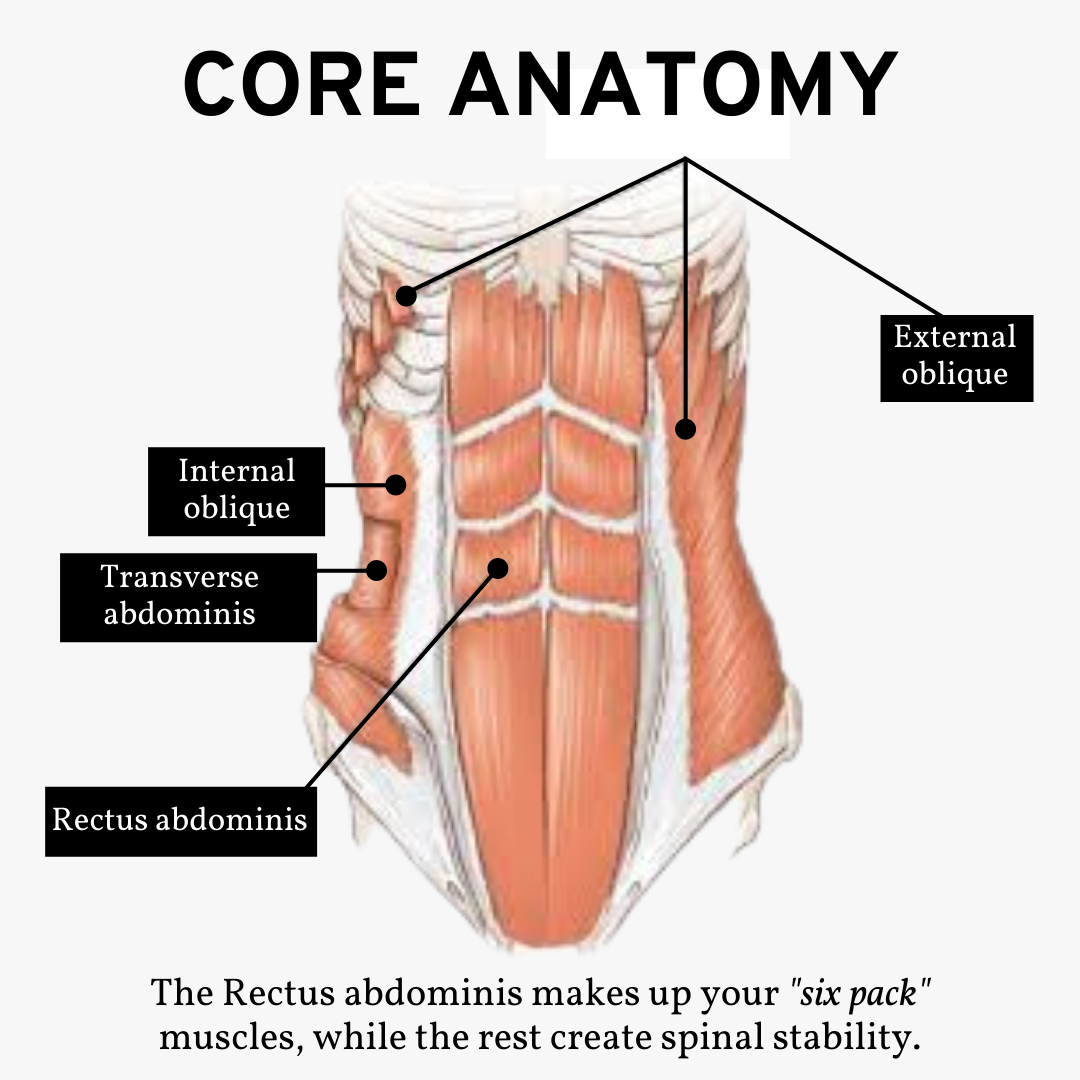
Your transverse abdominis (TVA) is a deep abdominal muscle that sits underneath the rectus abdominis, which are the “6-pack” muscles you normally think of when you think abs.
The TVA’s job is to brace the core and also has a role in breathing. If you hold your side, putting your fingers on your abs just inside your hip bone, when you blow your air all the way out you can feel your TVA tighten up.
There are some beginning breathing exercises you can do to start to engage those muscles again, but which ones you do and how much you can overload will depend on the person.
This goes for every core exercise you do postpartum - you need to pay attention to what works for you at the time and make sure you’re not seeing any doming or coning in your abdominals.
(Doming or coning is what happens when your intra abdominal pressure exceeds your core strength.)

If you ever see this, you know you’re not ready for that exercise, or you need to see if you can properly engage your TVA and try again.
Now, let's dive into the actual movements you can incorporate postpartum:
→ Diaphragmatic Breathing - The first exercise you can try postpartum is diaphragmatic breathing. This will help reconnect your breath and your core and helps your ribs, breath, core, and pelvic floor start to work together again.
→ Heel Slides: Another great early exercise is heel slides. Heel slides are done on your back in a sit-up position.
You start back taking a breath in, exhaling, and engaging your TA. You can help your TA engage by pressing your lower back down into the floor, closing that space that your natural curvature in your back creates. You then slowly slide one heel at a time out until your leg is extended, and then slowly slide it back in, back to the sit-up position.
→ Heel Drop: As you get stronger, you can start to implement exercises to overload the TVA. A good progression from the previous two exercises is a heel drop.
In a heel drop, you start in a tabletop position with knees up in the air at 90 degrees. You exhale to create the core tension just like in the heel slide exercise, but in this movement, you lower each heel, one side at a time to touch the floor, and then bring it back up.
→ Dead Bugs: Once you are strong at the previous movements, you can add the arms and do a dead bug exercise.
The dead bug maintains a stable core while both arms and legs are extending. You’ll lie on your back in tabletop position just like the heel drops, but with arms up. Extend one arm and the opposite leg as far as you can while keeping ribs down and core engaged.
→ Bridges: One more exercise that is safe to do early on postpartum is a bridge. Bridges will strengthen your pelvic floor, and strengthen glutes to help correct the anterior pelvic tilt caused by pregnancy. To bridge just lay on your back with knees bent.
Press through your heels and squeeze your glutes to lift your hips, making sure to keep your back neutral and not anteriorly tilted.
All of these exercises will improve your TVA strength and encourage your pelvic floor, TVA, and breath to work synergistically. Strengthening your core and correcting the lower cross syndrome you’ve developed over pregnancy will prevent back pain.
[*Note: Pelvic floor strengthening may take longer than you think it will. If you experience any incontinence or heaviness in the pelvic region, you’re not ready to progress. Bladder incontinence is so common to the point it is joked about in most mom circles, but it is not normal. If these exercises don’t prevent any urine leaking and it’s been more than 6 months, find a women’s health physical therapist.]
When you feel confident that your TVA and pelvic floor are reasonably strong, you can begin to add in other traditional core movements - a combination of rotation, anti-rotation, carrying, and flexion.
For each of these movements, just be very aware of how your core is functioning, and make sure there is no doming/coning in your core.
You also want to be aware of the pressure on your pelvic floor, and the space between your rectus abdominis. Some women can build back up to traditional exercises like sit up or crunches, planks, and woodchops fairly quickly without any issue.
If you suspect you might need to check for diastasis recti, watch this video and follow the instructions:
If you do have diastasis recti, or any pelvic floor issues not resolved by the breathing exercises, talk to a women’s health physical therapist.
6: STRENGTH TRAINING POSTPARTUM
Once you have worked on these basic breathing and core movements, and are cleared by your doctor to start incorporating exercise, be sure you’re still taking it slowly.
I know for myself I was eager to get back into a training routine and pushed beyond what I should have which ultimately set me back. Slow is fast when it comes to postpartum training.
The first thing to start with is walking.
Walking is a great exercise to start with because it will help with circulation, bring your heart rate up gently, help you retrain your posture back to normal and away from the pregnancy posture. Plus you can take the baby with you!
When you’re ready to incorporate some resistance training, it’s important to keep in mind your core strength, your pelvic floor strength, and your posture.
To make sure you’re not overloading your core or pelvic floor strength, I like to start online clients out with mostly unilateral exercises. These allow overload for the muscles being targeted, but it can be done with a lower load, so it’s safer on the core and pelvic floor. An example here would be a split squat instead of a barbell back squat:
Another exercise I like a lot for new moms is a goblet squat. A goblet squat’s limiting factor will be upper back and core strength, not leg strength.
Another area of focus should be upper back strength.
While pregnant it’s common to develop upper and lower cross syndrome.
Lower cross means the lower back is overextended, glutes and core are weakened, the lower back is tight, and the hip flexors are tight.
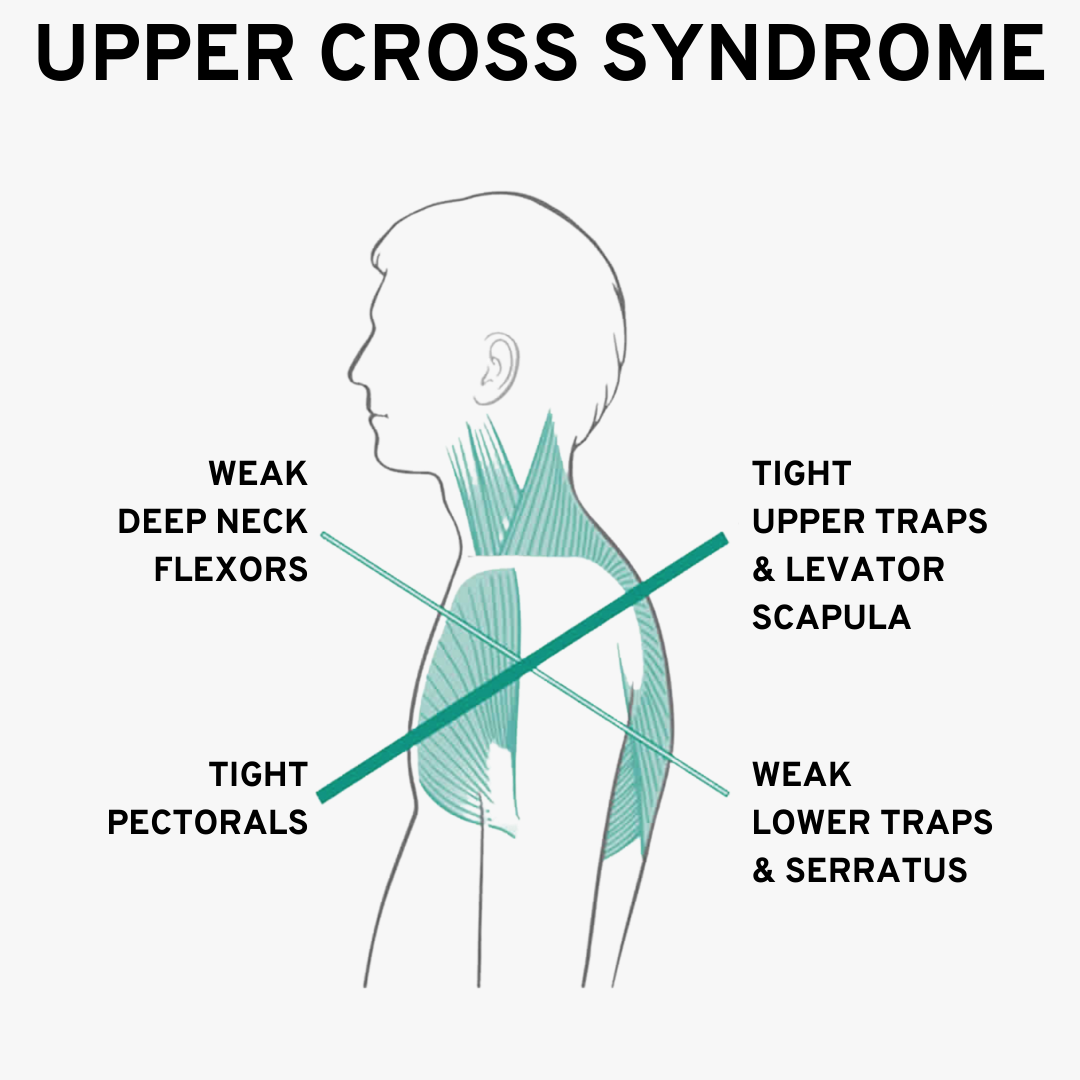
Upper cross means the shoulders and chest are tight and shortened, the neck is forward, and the upper back is weak.
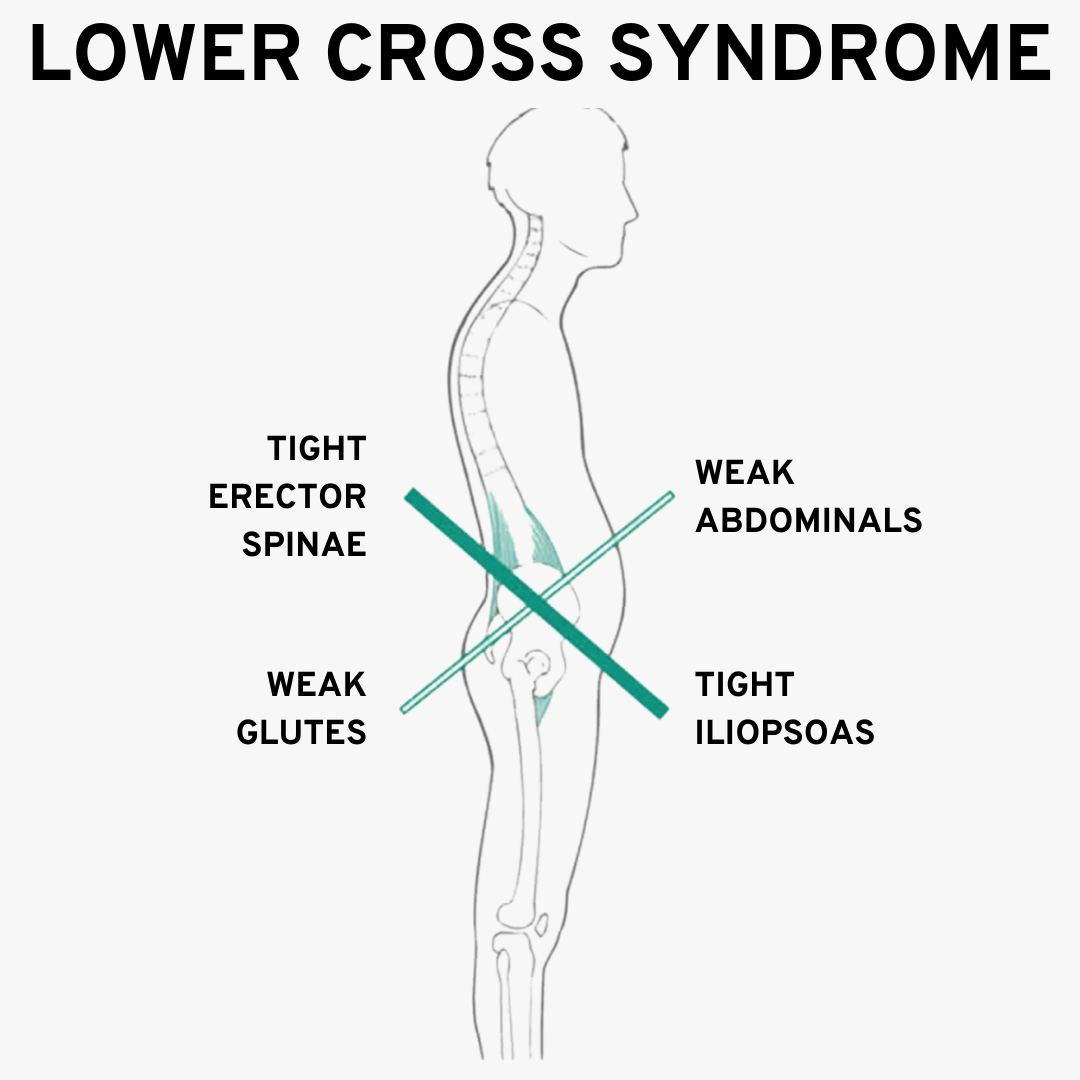
Nursing or feeding a baby several times per day exacerbates this issue because you’re hunched forward while feeding. To combat this you will need to focus on upper back strength.
Some of our favorite exercises for upper back strength are:
→ Upper Back Pulldowns:
→ Dumbbell Rows:
→ Cable Rear Delt Rows:
And really, you can't go wrong with any rowing variation.
I can say from NOT doing these things leading up to and after the first pregnancy to then doing them the second time around, the difference in upper back pain from nursing was night and day.
With all of these exercises and whatever training you choose, the most important thing is listening to your body, and not continuing to push through if anything feels “off”. Or even better, work with a coach to help guide you through the process, and tailor exercise selection to your unique needs.
Keep in mind this is a time that you’re healing from hopefully the largest trauma your body will have to go through. If you feel any looseness or weakness in your core, or any heaviness or weakness in your pelvic floor, back off of the intensity and consult your doctor or physical therapist.
Final Recommendations
→ Other experts to follow:
If you are interested in postpartum exercise, especially for the core, I recommend following a variety of experts on this topic.
These are physical therapists and trainers who have dedicated their whole practice to helping postpartum women rehab and strengthen their core and pelvic floor the proper way.
Here are some of the experts who I’ve personally learned a lot from and I recommend following:
→ Work with a coach:
Our coaching service was created to help people like you (with your average genetics, limiting schedules & responsibilities, and distinct nutritional needs), achieve your absolute best body composition ever.
We use individualized coaching to provide the proven nutrition & training methods, non-stop education, accountability, and authentic human connection you need to achieve the body you want (and guarantee you’ll know how to keep your results for a lifetime).
To learn more about what we do, click here now to apply for a free coaching strategy call with us.

Written for you by andrea rogers
Andrea Rogers is a certified nutrition coach, personal trainer, and coach for BairFit. Follow her on Instagram for more helpful training & nutrition content.
Keep Learning

Food Quality Vs. If It Fits Your MacrosProject type

How To Set (And Adjust) Your Macros For Any GoalProject type

The Glute Growth Blueprint [Feat. Alex Bush]Project type

The Ultimate Guide To Flexible DietingProject type

The Fat Loss GuideProject type

How To Fix Stalled Fat LossProject type

How To End A Diet (Without Losing Your Results)Project type

The Best Diet To Lose Weight PostpartumProject type

The 5 Keys To Maintaining Weight Loss ForeverProject type

How To Use Nutrition Periodization For Fat LossProject type

5 Ways To Get (and stay) MotivatedProject type

The Best Exercises For Building GlutesProject type

How To Hit Your Macros While TravelingProject type

The 6 Keys To Building Muscle For WomenProject type

Mom Of Five Photoshoot Prep (Nutrition Protocol, Training Strategy, Macro Adjustments, And More)Project type

Why Your Macros Aren't Working For Fat LossProject type

The Best Nutrition Strategy For Building MuscleProject type

Should You Bulk Or Cut First?Project type

Mom Of Five Photoshoot Prep (Nutrition Protocol, Training Strategy, Macro Adjustments, And More) - backupProject type

How To Sleep For Muscle Growth & Fat LossProject type

The Stubborn Muscle Solution For Your Delts, Quads, Hamstrings, and Back (Finally See Growth!)Project type

[GUIDE] The Best Diet To Get Lean In 12 WeeksProject type

Thyroid Health 101Project type

How To Change Your Body Fat Set PointProject type

The Core Training BlueprintProject type

How To Minimize Hunger On A DietProject type

Do You Need To Reverse Diet? [When/Why/How]Project type

The Ultimate Guide To PowerbuildingProject type

[GUIDE] How To Do Your First Pull-UpProject type

Building The Female PhysiqueProject type

Nutrition For Aesthetics [Beyond The Basics]Project type

The Definitive Guide To Periodizing NutritionProject type

The Ultimate Mini Cut Guide [Rapid Fat Loss]Project type

[Peak Week Guide] How To Get Photoshoot ReadyProject type

The Rapid Fat Loss ProtocolProject type

The 6 Worst Nutrition Mistakes You're MakingProject type

The Shoulder Training BlueprintProject type

Diet Breaks 101 (What/Why/How)Project type

CALORIE CYCLING 101: 6 Methods To Get You LeanerProject type

HORMONES: Are They Killing Your Results?Project type

The Complete Guide To Getting Visible AbsProject type

The P3 Fat Loss MethodProject type

How To Fix Your Gut Health & DigestionProject type

[Client Case Study] Achieving Lifestyle LeanProject type

How To Find Your Ideal DietProject type

Is Insulin Making You Fat?Project type

Why Fat Loss Stalls [And What To Do]Project type

The Complete Guide To Training At HomeProject type

The Body Composition Change BlueprintProject type

The 6 Most Helpful Things I've Learned In The Last Year [Training, Nutrition, & Coaching]Project type

[Program Design Masterclass] The Full Body SplitProject type

[GUIDE] How To Avoid Holiday Fat GainProject type

Do You Need To Reverse Diet?Project type

How To Stay Lean While Traveling/On VacationProject type

Client Case Study: 6 Months To Photoshoot LeanProject type

[GUIDE] Beat The Skinny-Fat PhysiqueProject type

[10 TIPS] How To Stay Lean For LifeProject type

[KEY TO CLIENT SUCCESS] The Motivation ManualProject type

[GUIDE] The Core Training BlueprintProject type

Fat Loss For Women: The Complete GuideProject type

How To Get Bigger ArmsProject type

Strategies To Make Dieting Suck LessProject type

Dealing With Fat Loss StallsProject type

Compound Exercises vs. Isolation ExercisesProject type

Are Any Supplements Worth The Cost?Project type

7 Diet & Nutrition Tips For Fitness And HealthProject type

Is The Fitness Industry Full of Lies?Project type

The Lean Gains BlueprintProject type

My 3 Favorite Movements For Each Muscle GroupProject type

Can You Grow Your Calves or Is It All Genetics?Project type

The BEST Diet For Rapid Weight LossProject type

Does Eating Red Meat Cause Cancer?Project type

EVERYTHING You've Heard About Fat Loss Is A LIE.Project type

Is It Harder For Women To Get Abs?Project type

How To Get Toned ArmsProject type

How Often Should I Go To The Gym?Project type

How To Prioritize Cardio Vs. WeightliftingProject type

Does Gut Health Effect Weight Loss?Project type

Are Group Fitness Classes Effective?Project type

A Beginner's Guide To Intermittent FastingProject type

Can't Do A Chin-Up? Do This FirstProject type

Best Exercises For Defined ShouldersProject type

Fix Your Back PainProject type

Why can't I gain more muscleProject type

How to build great bicepsProject type

How to get AbsProject type

How to end a diet (without losing your results)Project type

The Best Diet To Lose Weight PostpartumProject type

The 5 Keys To Maintaining Weight Loss ForeverProject type





























































































